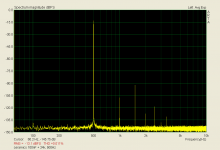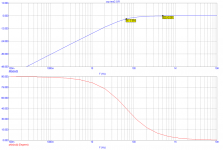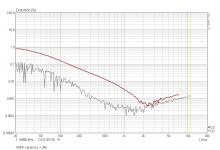But the pleasure of knowing you removed one by adding a servo is known to make things sound better !
Yes, it's just that, a feeling, beacuse substituning caps with a servo circuit is no guarantee of anything. You are substituting a single component or two with a whole circuit, with all its internal parameters. Once you hear the "breathing" or "pumping" effect of a not-so-well-done servo, you will know exactly what I mean.
Of course, you could now say that you meant a well done servo, but then I could say a beter choice of the capacitors would have removed many a problem.
Personally, I also prefer a DC servo to any capacitor, but that's another whole new hradache, how to make it so it does what it's supposed to do but with no negative side effects. The maths are simple enough, but the sound? Not necessarily so.
But the pleasure of knowing you removed one by adding a servo is known to make things sound better !
To be fair, I've been using servos on my preamp circuits since the '70s. David Berning was the instigator in that particular case. 😀
Dejan, in my world that Marantz is flawed; the H/K sounds like it's on the money.
I'm on month three of my "monster" H/K ... and boy - it is "on the money".
I'm glad I picked it's EF3 for the forum's projects. 100% thermal , no smoke ,
and really "on the money" !
OS
-105DB ? Ok, i think we can afford one (and only one) in a system. (In a servo, as example ;-)
Yes.
Fundamental is -10.7dB (you need to read fundamental amplitude), so it is -95dB in fact. Still good. Getting worse with lower frequency, as voltage across the cap is rising.
Attachments
Last edited:
I'm with John on this, I hate to admit 😉
You can get no nonlinearity from linear models, but the model is only used to look at linear effects, like charging/discharging.
If you want to know whether DA can lead to non-linearities, you need a model that includes more accurately any nonlinear soakage-release effects - if these are there; I don't know that.
But saying that DA cannot lead to nonlinearities because the model has only linear elements is a prime example of circular reasonoing.
How does DA manifest other than during charging/discharging?
se
Yes and no.No-one is suggesting to use it- polyprop caps are cheap and available. It's just somewhat surprising that it works as well as it does and a nice demonstration of what many of us have been saying: coupling caps just aren't that critical.
Decoupling can be critical, especially NFB shunt capacitors.
Dan.
Yes and no.
Decoupling can be critical, especially NFB shunt capacitors.
That's not decoupling. And since those caps are typically 10-100uF, good luck trying to get a ceramic cap of that value.
Yes, but they are pretty good at HF, no ? So why not use them in // with other brands as power shunts? If i'm looking for near perfect, I use a 1/10 value for each. Like 1000µ lityc,, 100µ lityc, 10µ film, 1µ film, 0.1µ ceramic.
PMA, thanks for all this very instructive measurements.
PMA, thanks for all this very instructive measurements.
Last edited:
DA is not defined to be linear because it arises from a linear model. DA has been found to be linear and hence can be modelled by linear elements.
How was it found to be linear if not by looking at this model? Isn't this the chicken versus the egg?
I am still puzzled by your attempt to distinguish between "charge/discharge" and audio use of capacitors.
No I am not. I am perfectly aware that the use of a cap is not different in, say, space telescopes or audio. Except maybe the distance to the listener ;-)
Jan
How does DA manifest other than during charging/discharging?
se
It doesn't.
Jan
Decoupling can be critical, especially NFB shunt capacitors.
Mouser's listing 2,198 ceramic caps between 10uF and 330uF. Looks like your luck's in 😀
MLCCs | Mouser
It doesn't.
Then if we can accurately model its charge/discharge behavior with linear elements, I'm just not seeing any room for non-linearity. What am I missing?
se
This give-me an idea. My next system will have a 3 position switch: "Impressive", "Transparent", "agreeable".
Too late. Hafler - Perfecting hifidelity audio for over 60 years.
Then if we can accurately model its charge/discharge behavior with linear elements, I'm just not seeing any room for non-linearity. What am I missing?
se
What I wonder is whether we can indeed accurately model charge/discharge behaviour with linear elements. Why are we so sure we can?
Jan
Then if we can accurately model its charge/discharge behavior with linear elements, I'm just not seeing any room for non-linearity. What am I missing?
se
Steve it's pretty easy to demonstrate that there is non-linearity. My point in the first place was that the pulse bridge test showed the charge/discharge issues of DA NOT separated from any underlying additional distortion. IMHO this sensationalized the issues at hand. If you went back to what was written at the time you would find a lot of nonsense.
What I wonder is whether we can indeed accurately model charge/discharge behaviour with linear elements. Why are we so sure we can?
Jan
Progressive fitting to the R/C model until there is an irreducible residue, this is a mathematical exercise probably relatively trivial to a modeling/math expert. A few steps on the residual from the pulse test left very little residue, it was clear no one was interested so I dropped it.
If you went back to what was written at the time you would find a lot of nonsense.
There is still a lot of nonsense. but now words like 'quantum' are used 🙂
Progressive fitting to the R/C model until there is an irreducible residue, this is a mathematical exercise probably relatively trivial to a modeling/math expert. A few steps on the residual from the pulse test left very little residue, it was clear no one was interested so I dropped it.
But that residual would be the nonlinear component, at least if we are reasonably sure it is not the limitation of the modelling accuracy.
Jan
- Status
- Not open for further replies.
- Home
- Member Areas
- The Lounge
- John Curl's Blowtorch preamplifier part II



